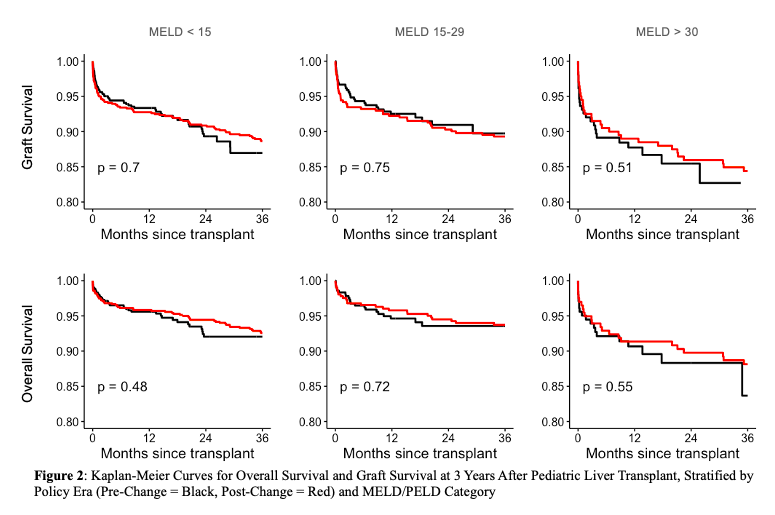
Pediatric liver transplantation in the acuity circles era
Yusuf Ciftci1, Vina L Nguyen1, Elizabeth A King1.
1Department of Surgery, Johns Hopkins University School of Medicine, Baltimore, MD, United States
Introduction: In 2020, the liver transplant (LT) allocation system shifted from local allocation practices to larger acuity circles (AC) with the goal of reducing variation in median MELD scores at transplant (MMAT). We investigated survival and waitlist outcomes in the AC era.
Methods: Pediatric (<19 years old) liver-only transplants from 2017-2023 in the United Network for Organ Sharing (UNOS) database were identified and divided based on policy era. We performed univariate and multivariate Cox regression to identify hazard ratios for 1-year and 3-year OS and GS. 90-day and 1-year transplant probability and mortality were assessed using cumulative incidence plots and cause-specific hazard ratios.
Results: Our final study cohort consisted of 2803 pediatric transplant recipients, of which 1373 were transplanted before AC and 1430 were transplanted after AC. Total cold ischemia time (6.13 hours vs. 6.68 hours, p<0.001) and distance travelled (196 nm to 325 nm, p<0.001) were significantly higher in the AC era. There were no significant differences in 1-year OS (p=0.58), 1-year GS (p=0.74), 3-year OS (p=0.35), and 3-year GS (p=0.71) between policy eras, a finding that persisted on multivariable cox regression. A similar trend was observed after stratifying the study cohort by MELD category. Cause-specific hazard ratios demonstrated no significant differences in 90-day and 1-year WL mortality and transplant probability.
Conclusions: Our findings suggest that AC had no significant impact on survival or WL outcomes for the pediatric LT population. Policies which increase organ availability and optimize allocation are needed to improve outcomes in the pediatric LT population.

The Pozefsky Scholars Program. Johns Hopkins University School of Medicine Dean's Year of Research.
The WebApp is sponsored by:

If you have any questions during the meeting, please go to the registration desk. Our emails will be monitored sporadically.
REGISTRATION DESK OPENING TIMES
Thursday, May 1, 2025, 07:00-17:30 Friday, May 2, 2025, 07:00-12:00